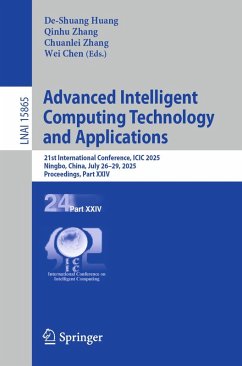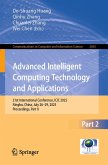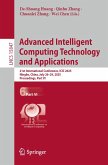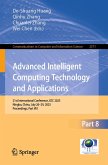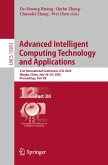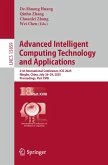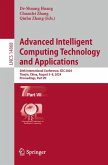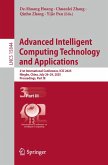Advanced Intelligent Computing Technology and Applications (eBook, PDF)
21st International Conference, ICIC 2025, Ningbo, China, July 26-29, 2025, Proceedings, Part XXIV
Redaktion: Huang, De-Shuang; Chen, Wei; Zhang, Chuanlei; Zhang, Qinhu
64,95 €
64,95 €
inkl. MwSt.
Sofort per Download lieferbar

32 °P sammeln
64,95 €
Als Download kaufen

64,95 €
inkl. MwSt.
Sofort per Download lieferbar

32 °P sammeln
Jetzt verschenken
Alle Infos zum eBook verschenken
64,95 €
inkl. MwSt.
Sofort per Download lieferbar
Alle Infos zum eBook verschenken

32 °P sammeln
Advanced Intelligent Computing Technology and Applications (eBook, PDF)
21st International Conference, ICIC 2025, Ningbo, China, July 26-29, 2025, Proceedings, Part XXIV
Redaktion: Huang, De-Shuang; Chen, Wei; Zhang, Chuanlei; Zhang, Qinhu
- Format: PDF
- Merkliste
- Auf die Merkliste
- Bewerten Bewerten
- Teilen
- Produkt teilen
- Produkterinnerung
- Produkterinnerung

Bitte loggen Sie sich zunächst in Ihr Kundenkonto ein oder registrieren Sie sich bei
bücher.de, um das eBook-Abo tolino select nutzen zu können.
Hier können Sie sich einloggen
Hier können Sie sich einloggen
Sie sind bereits eingeloggt. Klicken Sie auf 2. tolino select Abo, um fortzufahren.

Bitte loggen Sie sich zunächst in Ihr Kundenkonto ein oder registrieren Sie sich bei bücher.de, um das eBook-Abo tolino select nutzen zu können.
The 20-volume set LNCS 15842-15861, together with the 4-volume set LNAI 15862-15865 and the 4-volume set LNBI 15866-15869, constitutes the refereed proceedings of the 21st International Conference on Intelligent Computing, ICIC 2025, held in Ningbo, China, during July 26-29, 2025.
The 1206 papers presented in these proceedings books were carefully reviewed and selected from 4032 submissions. They deal with emerging and challenging topics in artificial intelligence, machine learning, pattern recognition, bioinformatics, and computational biology.
- Geräte: PC
- ohne Kopierschutz
- eBook Hilfe
- Größe: 52.58MB
Andere Kunden interessierten sich auch für
![Advanced Intelligent Computing Technology and Applications (eBook, PDF) Advanced Intelligent Computing Technology and Applications (eBook, PDF)]() Advanced Intelligent Computing Technology and Applications (eBook, PDF)72,95 €
Advanced Intelligent Computing Technology and Applications (eBook, PDF)72,95 €![Advanced Intelligent Computing Technology and Applications (eBook, PDF) Advanced Intelligent Computing Technology and Applications (eBook, PDF)]() Advanced Intelligent Computing Technology and Applications (eBook, PDF)59,95 €
Advanced Intelligent Computing Technology and Applications (eBook, PDF)59,95 €![Advanced Intelligent Computing Technology and Applications (eBook, PDF) Advanced Intelligent Computing Technology and Applications (eBook, PDF)]() Advanced Intelligent Computing Technology and Applications (eBook, PDF)72,95 €
Advanced Intelligent Computing Technology and Applications (eBook, PDF)72,95 €![Advanced Intelligent Computing Technology and Applications (eBook, PDF) Advanced Intelligent Computing Technology and Applications (eBook, PDF)]() Advanced Intelligent Computing Technology and Applications (eBook, PDF)64,95 €
Advanced Intelligent Computing Technology and Applications (eBook, PDF)64,95 €![Advanced Intelligent Computing Technology and Applications (eBook, PDF) Advanced Intelligent Computing Technology and Applications (eBook, PDF)]() Advanced Intelligent Computing Technology and Applications (eBook, PDF)64,95 €
Advanced Intelligent Computing Technology and Applications (eBook, PDF)64,95 €![Advanced Intelligent Computing Technology and Applications (eBook, PDF) Advanced Intelligent Computing Technology and Applications (eBook, PDF)]() Advanced Intelligent Computing Technology and Applications (eBook, PDF)59,95 €
Advanced Intelligent Computing Technology and Applications (eBook, PDF)59,95 €![Advanced Intelligent Computing Technology and Applications (eBook, PDF) Advanced Intelligent Computing Technology and Applications (eBook, PDF)]() Advanced Intelligent Computing Technology and Applications (eBook, PDF)59,95 €
Advanced Intelligent Computing Technology and Applications (eBook, PDF)59,95 €-
-
-
The 20-volume set LNCS 15842-15861, together with the 4-volume set LNAI 15862-15865 and the 4-volume set LNBI 15866-15869, constitutes the refereed proceedings of the 21st International Conference on Intelligent Computing, ICIC 2025, held in Ningbo, China, during July 26-29, 2025.
The 1206 papers presented in these proceedings books were carefully reviewed and selected from 4032 submissions. They deal with emerging and challenging topics in artificial intelligence, machine learning, pattern recognition, bioinformatics, and computational biology.
The 1206 papers presented in these proceedings books were carefully reviewed and selected from 4032 submissions. They deal with emerging and challenging topics in artificial intelligence, machine learning, pattern recognition, bioinformatics, and computational biology.
Dieser Download kann aus rechtlichen Gründen nur mit Rechnungsadresse in A, B, BG, CY, CZ, D, DK, EW, E, FIN, F, GR, HR, H, IRL, I, LT, L, LR, M, NL, PL, P, R, S, SLO, SK ausgeliefert werden.
Produktdetails
- Produktdetails
- Verlag: Springer Nature Singapore
- Seitenzahl: 521
- Erscheinungstermin: 23. Juli 2025
- Englisch
- ISBN-13: 9789819500208
- Artikelnr.: 74986855
- Verlag: Springer Nature Singapore
- Seitenzahl: 521
- Erscheinungstermin: 23. Juli 2025
- Englisch
- ISBN-13: 9789819500208
- Artikelnr.: 74986855
- Herstellerkennzeichnung Die Herstellerinformationen sind derzeit nicht verfügbar.
.- Natural Language Processing and Computational Linguistics.
.- Mongolian Multimodal Sentiment Analysis Based on Multi-Level Attention and Convolution-Enhanced Fusion.
.- Research on joint extraction of Chinese diabetes entity relations based on hybrid attention and hierarchical network.
.- SSC-SQL: A Text-to-SQL Generation Framework with Multi-Process Collaboration.
.- CoT Reasoning-Based Content Adaptation and Image Generation for Chinese Poetry.
.- Self-Attentive CycleGAN for Damaged Khitan Script Reconstruction.
.- A Hierarchical Prompt-Enhanced Mix-up Model with Graph Attention Networks for Academic Text Classification.
.- Dynamic Neural Transfer for Domain-Level Zero-Shot Cognitive Diagnosis.
.- Reassessing the Role of Chain-of-Thought in Sentiment Analysis: Insights and Limitations.
.- LENS-RMHR: Enhancing Telecom Fraud Detection with Large Language Model Neuron Selection.
.- GeneralCI: Do LLMs Have the Generalization Ability in Conducting Causal Inference.
.- Multimodal Sentiment Analysis of Mongolian Language Based on Gated Transformer and Adaptive Hyper-modality.
.- Towards a Concise Benchmark for Security Risk Evaluation in Large Language Models.
.- Personalized Prompt Attack Strategies Against Large Language Models.
.- MACCISA: A Multimodal Commonsense Knowledge Aware Model for Counterfactual Implicit Sentiment Analysis.
.- Concept-Guided Persona Perception with Commonsense Reasoning for Personalized Dialogue Generation.
.- Self-Distillation Model for Emotion Recognition with Cross-Modal Interaction and Graph Neural Networks.
.- Talk the Talk, Debate the Bias: LLM Alignment via Role-Play Rumble.
.- BERT-CHAB: Hierarchical Context Fusion with Adaptive Boundary Detection for Robust Chinese Named Entity Recognition in Noisy Social Media.
.- Personalized Emotion Prediction Using Instruction-Tuned Large Language Models.
.- BiCoT: Enhancing Large Language Model Reasoning Through Bidirectional Correction of Thought.
.- MAF-CPR: LLM-Based Multi-Agent Framework for Complex Pull Request Review in GitHub.
.- Definition Modeling for WSD and Semantic Perplexity-BERT Composite Score (SPBS).
.- Syntax and Semantic Dual-Enhanced Chinese Named Entity Recognition.
.- Improve Question Generation via Dual Perspective Key Phrase Selection.
.- OptiACL: Optimized Anchor Contrastive Learning Framework for Multimodal Conversational Emotion Recognition.
.- Implicit Validation Inference for Few-shot Named Entity Recognition.
.- Token Memory Transformer with Infinite Context.
.- FrameNet and Multiway Attention for Chinese Event Argument Extraction.
.- CoT-NER: A Reasoning Method via Chain of Thought for Chinese Named Entity Recognition.
.- Optimizing Knowledge Graph Reasoning via Global Relation Pruning with LLMs.
.- Document-level Relation Extraction with Retrieval-Augmented.
.- SARGAT: A Relation-Typed Graph Attention Network with Sentiment Distance-Aware Attention for Aspect-Based Sentiment Analysis.
.- HierDaC: Detecting Long-Text Misinformation via Hierarchical Divide-and-Conquer.
.- Rethinking the Chain-of-Thought: The Roles of In-Context Learning and Pretrained Priors.
.- UOS-FSNER: Unified One-stage Few-shot Named Entity Recognition.
.- HealthBridge: A Cross-lingual Clustering Framework for English-Chinese Health News.
.- MedLite: a lightweight medical multimodal model based on knowledge distillation and inference optimization.
.- Do Not Say It Directly: Generating Indirect Expressions with Large Language Models.
.- ME-CWNER: Multi-metadata Embedding based Chinese Named Entity Recognition for Wheat Diseases and Pests.
.- Join Social and Temporal Information for Rumor Detection.
.- Advancing Low-Resource Machine Translation: A Unified Data Selection and Scoring Optimization Framework.
.- Multi-modal Entity Linking Model based on Knowledge Distillation.
.- A Semantic-Structural Synergistic Chunking Method for Enhancing Domain Specific LLM Fine-Tuning.
.- Mongolian Multimodal Sentiment Analysis Based on Multi-Level Attention and Convolution-Enhanced Fusion.
.- Research on joint extraction of Chinese diabetes entity relations based on hybrid attention and hierarchical network.
.- SSC-SQL: A Text-to-SQL Generation Framework with Multi-Process Collaboration.
.- CoT Reasoning-Based Content Adaptation and Image Generation for Chinese Poetry.
.- Self-Attentive CycleGAN for Damaged Khitan Script Reconstruction.
.- A Hierarchical Prompt-Enhanced Mix-up Model with Graph Attention Networks for Academic Text Classification.
.- Dynamic Neural Transfer for Domain-Level Zero-Shot Cognitive Diagnosis.
.- Reassessing the Role of Chain-of-Thought in Sentiment Analysis: Insights and Limitations.
.- LENS-RMHR: Enhancing Telecom Fraud Detection with Large Language Model Neuron Selection.
.- GeneralCI: Do LLMs Have the Generalization Ability in Conducting Causal Inference.
.- Multimodal Sentiment Analysis of Mongolian Language Based on Gated Transformer and Adaptive Hyper-modality.
.- Towards a Concise Benchmark for Security Risk Evaluation in Large Language Models.
.- Personalized Prompt Attack Strategies Against Large Language Models.
.- MACCISA: A Multimodal Commonsense Knowledge Aware Model for Counterfactual Implicit Sentiment Analysis.
.- Concept-Guided Persona Perception with Commonsense Reasoning for Personalized Dialogue Generation.
.- Self-Distillation Model for Emotion Recognition with Cross-Modal Interaction and Graph Neural Networks.
.- Talk the Talk, Debate the Bias: LLM Alignment via Role-Play Rumble.
.- BERT-CHAB: Hierarchical Context Fusion with Adaptive Boundary Detection for Robust Chinese Named Entity Recognition in Noisy Social Media.
.- Personalized Emotion Prediction Using Instruction-Tuned Large Language Models.
.- BiCoT: Enhancing Large Language Model Reasoning Through Bidirectional Correction of Thought.
.- MAF-CPR: LLM-Based Multi-Agent Framework for Complex Pull Request Review in GitHub.
.- Definition Modeling for WSD and Semantic Perplexity-BERT Composite Score (SPBS).
.- Syntax and Semantic Dual-Enhanced Chinese Named Entity Recognition.
.- Improve Question Generation via Dual Perspective Key Phrase Selection.
.- OptiACL: Optimized Anchor Contrastive Learning Framework for Multimodal Conversational Emotion Recognition.
.- Implicit Validation Inference for Few-shot Named Entity Recognition.
.- Token Memory Transformer with Infinite Context.
.- FrameNet and Multiway Attention for Chinese Event Argument Extraction.
.- CoT-NER: A Reasoning Method via Chain of Thought for Chinese Named Entity Recognition.
.- Optimizing Knowledge Graph Reasoning via Global Relation Pruning with LLMs.
.- Document-level Relation Extraction with Retrieval-Augmented.
.- SARGAT: A Relation-Typed Graph Attention Network with Sentiment Distance-Aware Attention for Aspect-Based Sentiment Analysis.
.- HierDaC: Detecting Long-Text Misinformation via Hierarchical Divide-and-Conquer.
.- Rethinking the Chain-of-Thought: The Roles of In-Context Learning and Pretrained Priors.
.- UOS-FSNER: Unified One-stage Few-shot Named Entity Recognition.
.- HealthBridge: A Cross-lingual Clustering Framework for English-Chinese Health News.
.- MedLite: a lightweight medical multimodal model based on knowledge distillation and inference optimization.
.- Do Not Say It Directly: Generating Indirect Expressions with Large Language Models.
.- ME-CWNER: Multi-metadata Embedding based Chinese Named Entity Recognition for Wheat Diseases and Pests.
.- Join Social and Temporal Information for Rumor Detection.
.- Advancing Low-Resource Machine Translation: A Unified Data Selection and Scoring Optimization Framework.
.- Multi-modal Entity Linking Model based on Knowledge Distillation.
.- A Semantic-Structural Synergistic Chunking Method for Enhancing Domain Specific LLM Fine-Tuning.
.- Natural Language Processing and Computational Linguistics.
.- Mongolian Multimodal Sentiment Analysis Based on Multi-Level Attention and Convolution-Enhanced Fusion.
.- Research on joint extraction of Chinese diabetes entity relations based on hybrid attention and hierarchical network.
.- SSC-SQL: A Text-to-SQL Generation Framework with Multi-Process Collaboration.
.- CoT Reasoning-Based Content Adaptation and Image Generation for Chinese Poetry.
.- Self-Attentive CycleGAN for Damaged Khitan Script Reconstruction.
.- A Hierarchical Prompt-Enhanced Mix-up Model with Graph Attention Networks for Academic Text Classification.
.- Dynamic Neural Transfer for Domain-Level Zero-Shot Cognitive Diagnosis.
.- Reassessing the Role of Chain-of-Thought in Sentiment Analysis: Insights and Limitations.
.- LENS-RMHR: Enhancing Telecom Fraud Detection with Large Language Model Neuron Selection.
.- GeneralCI: Do LLMs Have the Generalization Ability in Conducting Causal Inference.
.- Multimodal Sentiment Analysis of Mongolian Language Based on Gated Transformer and Adaptive Hyper-modality.
.- Towards a Concise Benchmark for Security Risk Evaluation in Large Language Models.
.- Personalized Prompt Attack Strategies Against Large Language Models.
.- MACCISA: A Multimodal Commonsense Knowledge Aware Model for Counterfactual Implicit Sentiment Analysis.
.- Concept-Guided Persona Perception with Commonsense Reasoning for Personalized Dialogue Generation.
.- Self-Distillation Model for Emotion Recognition with Cross-Modal Interaction and Graph Neural Networks.
.- Talk the Talk, Debate the Bias: LLM Alignment via Role-Play Rumble.
.- BERT-CHAB: Hierarchical Context Fusion with Adaptive Boundary Detection for Robust Chinese Named Entity Recognition in Noisy Social Media.
.- Personalized Emotion Prediction Using Instruction-Tuned Large Language Models.
.- BiCoT: Enhancing Large Language Model Reasoning Through Bidirectional Correction of Thought.
.- MAF-CPR: LLM-Based Multi-Agent Framework for Complex Pull Request Review in GitHub.
.- Definition Modeling for WSD and Semantic Perplexity-BERT Composite Score (SPBS).
.- Syntax and Semantic Dual-Enhanced Chinese Named Entity Recognition.
.- Improve Question Generation via Dual Perspective Key Phrase Selection.
.- OptiACL: Optimized Anchor Contrastive Learning Framework for Multimodal Conversational Emotion Recognition.
.- Implicit Validation Inference for Few-shot Named Entity Recognition.
.- Token Memory Transformer with Infinite Context.
.- FrameNet and Multiway Attention for Chinese Event Argument Extraction.
.- CoT-NER: A Reasoning Method via Chain of Thought for Chinese Named Entity Recognition.
.- Optimizing Knowledge Graph Reasoning via Global Relation Pruning with LLMs.
.- Document-level Relation Extraction with Retrieval-Augmented.
.- SARGAT: A Relation-Typed Graph Attention Network with Sentiment Distance-Aware Attention for Aspect-Based Sentiment Analysis.
.- HierDaC: Detecting Long-Text Misinformation via Hierarchical Divide-and-Conquer.
.- Rethinking the Chain-of-Thought: The Roles of In-Context Learning and Pretrained Priors.
.- UOS-FSNER: Unified One-stage Few-shot Named Entity Recognition.
.- HealthBridge: A Cross-lingual Clustering Framework for English-Chinese Health News.
.- MedLite: a lightweight medical multimodal model based on knowledge distillation and inference optimization.
.- Do Not Say It Directly: Generating Indirect Expressions with Large Language Models.
.- ME-CWNER: Multi-metadata Embedding based Chinese Named Entity Recognition for Wheat Diseases and Pests.
.- Join Social and Temporal Information for Rumor Detection.
.- Advancing Low-Resource Machine Translation: A Unified Data Selection and Scoring Optimization Framework.
.- Multi-modal Entity Linking Model based on Knowledge Distillation.
.- A Semantic-Structural Synergistic Chunking Method for Enhancing Domain Specific LLM Fine-Tuning.
.- Mongolian Multimodal Sentiment Analysis Based on Multi-Level Attention and Convolution-Enhanced Fusion.
.- Research on joint extraction of Chinese diabetes entity relations based on hybrid attention and hierarchical network.
.- SSC-SQL: A Text-to-SQL Generation Framework with Multi-Process Collaboration.
.- CoT Reasoning-Based Content Adaptation and Image Generation for Chinese Poetry.
.- Self-Attentive CycleGAN for Damaged Khitan Script Reconstruction.
.- A Hierarchical Prompt-Enhanced Mix-up Model with Graph Attention Networks for Academic Text Classification.
.- Dynamic Neural Transfer for Domain-Level Zero-Shot Cognitive Diagnosis.
.- Reassessing the Role of Chain-of-Thought in Sentiment Analysis: Insights and Limitations.
.- LENS-RMHR: Enhancing Telecom Fraud Detection with Large Language Model Neuron Selection.
.- GeneralCI: Do LLMs Have the Generalization Ability in Conducting Causal Inference.
.- Multimodal Sentiment Analysis of Mongolian Language Based on Gated Transformer and Adaptive Hyper-modality.
.- Towards a Concise Benchmark for Security Risk Evaluation in Large Language Models.
.- Personalized Prompt Attack Strategies Against Large Language Models.
.- MACCISA: A Multimodal Commonsense Knowledge Aware Model for Counterfactual Implicit Sentiment Analysis.
.- Concept-Guided Persona Perception with Commonsense Reasoning for Personalized Dialogue Generation.
.- Self-Distillation Model for Emotion Recognition with Cross-Modal Interaction and Graph Neural Networks.
.- Talk the Talk, Debate the Bias: LLM Alignment via Role-Play Rumble.
.- BERT-CHAB: Hierarchical Context Fusion with Adaptive Boundary Detection for Robust Chinese Named Entity Recognition in Noisy Social Media.
.- Personalized Emotion Prediction Using Instruction-Tuned Large Language Models.
.- BiCoT: Enhancing Large Language Model Reasoning Through Bidirectional Correction of Thought.
.- MAF-CPR: LLM-Based Multi-Agent Framework for Complex Pull Request Review in GitHub.
.- Definition Modeling for WSD and Semantic Perplexity-BERT Composite Score (SPBS).
.- Syntax and Semantic Dual-Enhanced Chinese Named Entity Recognition.
.- Improve Question Generation via Dual Perspective Key Phrase Selection.
.- OptiACL: Optimized Anchor Contrastive Learning Framework for Multimodal Conversational Emotion Recognition.
.- Implicit Validation Inference for Few-shot Named Entity Recognition.
.- Token Memory Transformer with Infinite Context.
.- FrameNet and Multiway Attention for Chinese Event Argument Extraction.
.- CoT-NER: A Reasoning Method via Chain of Thought for Chinese Named Entity Recognition.
.- Optimizing Knowledge Graph Reasoning via Global Relation Pruning with LLMs.
.- Document-level Relation Extraction with Retrieval-Augmented.
.- SARGAT: A Relation-Typed Graph Attention Network with Sentiment Distance-Aware Attention for Aspect-Based Sentiment Analysis.
.- HierDaC: Detecting Long-Text Misinformation via Hierarchical Divide-and-Conquer.
.- Rethinking the Chain-of-Thought: The Roles of In-Context Learning and Pretrained Priors.
.- UOS-FSNER: Unified One-stage Few-shot Named Entity Recognition.
.- HealthBridge: A Cross-lingual Clustering Framework for English-Chinese Health News.
.- MedLite: a lightweight medical multimodal model based on knowledge distillation and inference optimization.
.- Do Not Say It Directly: Generating Indirect Expressions with Large Language Models.
.- ME-CWNER: Multi-metadata Embedding based Chinese Named Entity Recognition for Wheat Diseases and Pests.
.- Join Social and Temporal Information for Rumor Detection.
.- Advancing Low-Resource Machine Translation: A Unified Data Selection and Scoring Optimization Framework.
.- Multi-modal Entity Linking Model based on Knowledge Distillation.
.- A Semantic-Structural Synergistic Chunking Method for Enhancing Domain Specific LLM Fine-Tuning.
